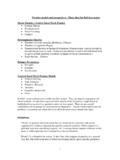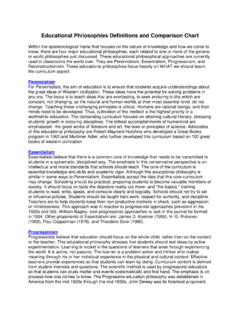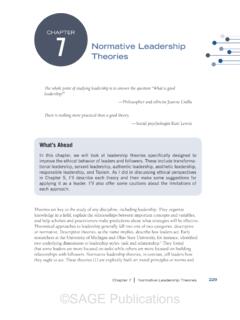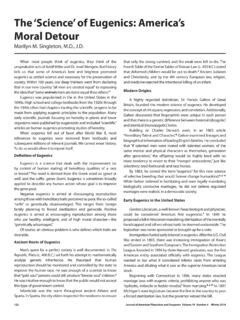Transcription of Theories, models and perspectives - Cheat sheet for field ...
1 1 theories , models and perspectives - Cheat sheet for field instructors Major theories Used in Social Work Practice Systems Theory Psychodynamic Social Learning Conflict Developmental theories theories of moral reasoning (Kohlberg, Gilligan) theories of cognition (Piaget) Transpersonal theories of human development (Transpersonal means beyond or through the persona or mask. Going beyond identity rooted in the individual body or ego to include spiritual experience or higher levels of consciousness.) Stage theories Erikson Primary perspectives Strengths Feminist Eco-Systems Current Social Work Practice models Problem Solving Task-Centered Solution Focused Narrative Cognitive-Behavioral Crisis In brief, social work practice models are like recipes.
2 they are step-by-step guides for client sessions. perspectives represent what aspects of the session are emphasized or highlighted in a session ( questions asked or time spent). theories are overall explanations of the person-in-environment configuration. theories help explain why the problem is occurring and where the most efficient intervention should take place. Definitions: Theory A general statement about the real world whose essential truth can be supported by evidence obtained through the scientific method. Must explain in a provable way why something happens. Ex: Learning theory explains behavior on the basis of what organisms have learned from the environment.
3 model Is a blueprint for action. It describes what happens in practice in a general way. Ex: The behavioral model (based on learning theory) gives specific guidelines 2 for how to effect change. If a parent complains that his child is having difficulty staying in his own bed at night and the parent has been allowing the child to sleep in his/her bed( thereby reinforcing the child s difficulty) the practitioner would help the parent to extinguish the behavior by removing the reinforcement. perspective A way of perceiving the world flows from a value position. Note: The perspective will influence choice of theory and model . Note: Payne ( 1997) argues that social work theory succeeds best when it contains all three elements of perspective , theory and model .
4 Example: Men who batter their partners Theory: Social learning theory men learn their violent behavior in their family of origin, and from a culture that rewards anger and violence in men; cognitive theory what men say to themselves in situations of stress increases their anger and their propensity to be violent. model : Cognitive-behavioral perspective : Feminist Definitions are from Syers & Boisen (2003) Course handout Payne, M. (1997). Modern Social Work Theory. Lyceum Books 1. Systems theories Those concepts that emphasize reciprocal relationships between the elements that constitute a whole. These concepts also emphasize the relationships among individuals, groups, organizations, or communities and mutually influencing factors in the environment.
5 Systems theories focus on the interrelationships of elements in nature, encompassing physics, chemistry, biology, and social relationships (general systems theory, ecological perspective , life model , and ecosystems perspective ). 2. Psychodynamic Theory Psychodynamic psychotherapy is concerned with how internal processes such as needs, drives, and emotions motivate human behavior. Emotions have a central place in human behavior. Unconscious, as well as conscious mental activity serves as the motivating force in human behavior. Early childhood experiences are central in the patterning of an individual s emotions, and therefore, central to problems of living throughout life.
6 Individuals may become overwhelmed by internal and/or external demands. Individuals frequently use ego defense mechanisms to avoid becoming overwhelmed by internal and/or external demands. Note: In current social work practice psychodynamic theory is what the social worker uses when s/he looks at early attachment relationships and the developmental history of the client which includes past trauma or abuse. In addition, social workers use this theory 3 in supervision to understand the dynamics of the helping relationship (transference, countertransference). 3. Social Learning - Social learning theory suggests that human behavior is learned as individuals interact with their environment.
7 Problem behavior is maintained by positive or negative reinforcement. Cognitive- behavioral therapy looks at what role thoughts play in maintaining the problem. Emphasis is on changing dysfunctional thoughts which influence behavior. Methods which stem from this theory are the gradual shaping of new behavior through positive and negative reinforcement, modeling, stress management: biofeedback, relaxation techniques, cognitive restructuring, imagery and systematic desensitization. 4. Conflict Theory This theory draws attention to conflict, dominance, and oppression in social life. Groups and individuals try to advance their own interests over the interests of others.
8 Power is unequally divided, and some social groups dominate others. Social order is based on the manipulation and control of nondominant groups by dominant groups. Lack of open conflict is a sign of exploitation. Social change is driven by conflict, with periods of change interrupting long periods of stability. Note: Social workers use this theory to understand clients who are experiencing oppression in some form or another in our capitalist society. Primary perspectives Strengths Stems from the work of Saleeby (1996) The social worker assumes that the client has multiple strengths. The social worker tries to assess the strengths of the client and emphasizes these strengths in the helping relationship.
9 Feminist This perspective takes into account the role of gender and the historical lack of power experienced by women in our society. Feminist social workers emphasize the collaborative relationship between the social worker and the client and place an emphasis on equality and empowerment of women in our society. Current Social Work Practice models Problem Solving The problem solving model focuses on understanding the problem, brainstorming possible solutions, having the client pick a solution, having the client try out a solution and then evaluating how the solution worked. 4 Task-Centered This model focuses on breaking down the problem into small tasks that the client can accomplish.
10 The social worker may use rehearsal, deadlines, and contracts, in order to help the client feel successful and motivated towards solving the problem. Solution Focused This model starts with the solution and then helps the client establish the steps that will lead to the solution. This model is the one that uses the miracle question to help clients envision the future that they want to obtain. Narrative This model uses letters and other methods to help the client re-author their lives. For a more in-depth explanation I suggest a very short user-friendly book titled, What is Narrative Therapy? by Alice Morgan (2000). Developmental theories Developmental theories focus on how behavior changes and stays the same across the life cycle.










